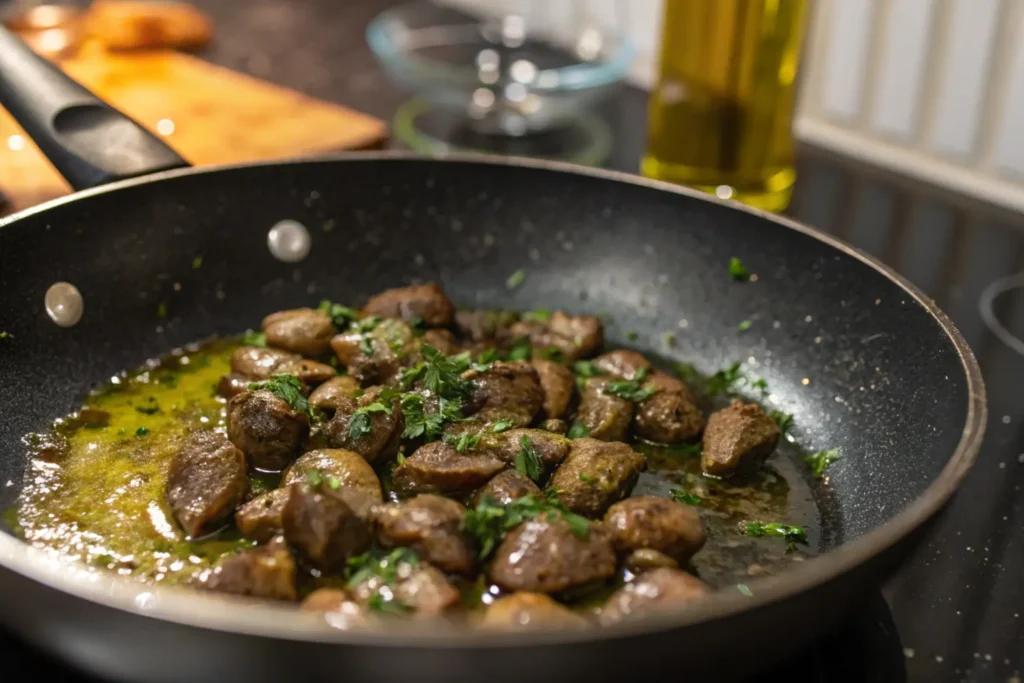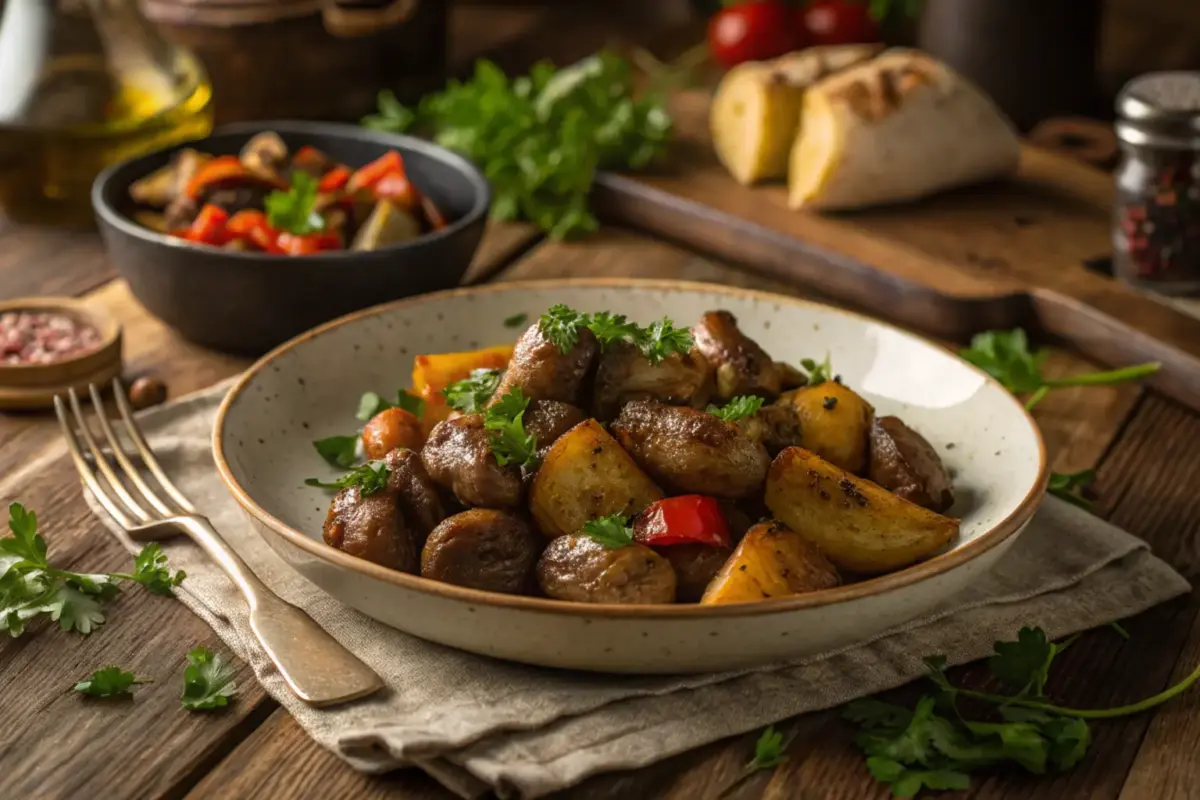What Are Chicken Hearts?
Nutritional Value of Chicken Hearts
Chicken hearts are a powerhouse of essential nutrients, offering a wide range of health benefits when incorporated into your diet. These small organ meats are exceptionally rich in protein, providing approximately 20 grams per 100-gram serving, which is vital for muscle repair and overall strength. Moreover, they are an excellent source of iron, zinc, and selenium, all of which play key roles in maintaining energy levels, supporting immune health, and promoting cellular repair.
In addition to their mineral content, chicken hearts are packed with vitamin B12, which is crucial for nerve function and red blood cell production. Furthermore, they contain Coenzyme Q10 (CoQ10), a compound known for its potential to improve cardiovascular health and reduce inflammation. Compared to other meats, they offer a unique balance of low fat and high-quality amino acids, making them an excellent choice for those seeking a nutrient-dense meal.
When prepared through sauteing, chicken hearts retain most of their nutrients due to the quick cooking process, making them an even healthier option. Incorporating sauteed chicken hearts into your meals not only diversifies your diet but also ensures you’re consuming a dish that supports your overall well-being. With their impressive nutrient profile, chicken hearts stand out as a valuable and delicious protein source.
Culinary Uses of Chicken Hearts Across Cultures
Chicken hearts have earned a cherished spot in cuisines worldwide due to their versatility and distinct flavor. In Brazilian churrasco, they are commonly grilled on skewers, seasoned with a simple blend of garlic, salt, and olive oil. Meanwhile, Japanese yakitori restaurants often feature them as bite-sized delicacies, brushed with a savory soy-based marinade and grilled to perfection.
In African and Southeast Asian cooking, chicken hearts are often stewed with aromatic spices, creating deeply flavorful dishes. Their compact size makes them ideal for quick cooking methods like sauteing, where they easily absorb marinades and seasonings. Whether used in hearty stews, as a protein addition to salads, or simply enjoyed as a snack, sauteed chicken hearts offer endless possibilities for creative culinary exploration.
Why Choose Sauteed Chicken Hearts?
Health Benefits of Sauteed Chicken Hearts
Eating sauteed chicken hearts offers numerous health benefits. Since they are rich in protein and low in carbohydrates, they are perfect for low-carb and high-protein diets. Their abundance of iron helps combat anemia, while zinc supports immune system function. Additionally, the presence of CoQ10 may aid in reducing inflammation and improving heart health.
Cooking chicken hearts through sauteing preserves their nutritional value by using minimal oil and high heat. This method ensures you get all the vital nutrients without unnecessary calories. Moreover, their natural richness in essential fatty acids contributes to skin and hair health. Incorporating sauteed chicken hearts into your meals is a smart choice for anyone aiming to maintain a nutrient-packed diet.
Taste Profile and Texture
The taste of sauteed chicken hearts is often described as earthy and mildly gamey, similar to dark meat poultry. Their tender yet slightly chewy texture makes them a unique culinary experience. When prepared correctly, their exterior develops a slight crispiness while the inside remains juicy. The natural umami of chicken hearts pairs beautifully with garlic, onions, and herbs, making them a versatile ingredient in both traditional and contemporary dishes.
For those who are hesitant about trying organ meats, chicken hearts are an excellent starting point. Their flavor is less intense than liver, and when sauteed, they take on the delightful nuances of the seasonings used. A properly seasoned plate of sauteed chicken hearts can easily win over even the most skeptical eater.
Preparing Chicken Hearts for Cooking
Cleaning and Trimming Chicken Hearts
Before cooking sauteed chicken hearts, proper preparation is essential. Start by rinsing the hearts thoroughly under cold water to remove any blood and impurities. Gently squeeze each heart to ensure it is clean inside and out. Next, trim off any visible fat and connective tissue using a sharp knife. This step not only improves the texture but also ensures even cooking.
Pay close attention to any leftover membranes, as they can make the dish less appealing. By dedicating time to cleaning and trimming, you create a solid foundation for flavorful and well-cooked sauteed chicken hearts.
Marination Techniques for Enhanced Flavor
Marinating chicken hearts is the key to enhancing their flavor. A simple marinade can consist of olive oil, minced garlic, soy sauce, lemon juice, and your favorite herbs or spices. For a bold taste, include ingredients like smoked paprika, chili flakes, or ginger. Allow the chicken hearts to marinate for at least 30 minutes, although longer marination—up to 24 hours—yields even more robust flavors.
Place the marinated chicken hearts in an airtight container or a resealable bag to ensure the flavors penetrate evenly. This step not only adds complexity to their natural taste but also helps tenderize the meat, ensuring every bite of your sauteed chicken hearts is bursting with flavor.
Step-by-Step Guide to Cooking Sauteed Chicken Hearts

Essential Ingredients and Tools
To cook perfect sauteed chicken hearts, gather these essential ingredients and tools:
- Fresh chicken hearts
- Olive oil or butter for sauteing
- Garlic and onions for added depth
- Salt, pepper, and spices of choice (e.g., smoked paprika, thyme)
- Fresh herbs like parsley for garnish
Tools you’ll need include a sharp knife, a cutting board, and a heavy-bottomed skillet or cast-iron pan. Preparing these items in advance ensures a smooth cooking process and allows you to focus on achieving the ideal texture and flavor.
Cooking Techniques: Mastering the Sautee
Begin by heating a small amount of oil or butter in your skillet over medium-high heat. Once the pan is hot, add minced garlic and onions, sauteing until fragrant. Add the marinated chicken hearts, ensuring they are spread in a single layer for even cooking. Stir occasionally, allowing the hearts to brown on all sides.
The key to perfect sauteed chicken hearts is avoiding overcooking. Cook them for 5-7 minutes or until they reach an internal temperature of 165°F (74°C). Overcooking can result in a tough texture, so it’s important to monitor them closely. Once cooked, remove them from the pan and let them rest briefly before serving.
Common Mistakes and How to Avoid Them
To achieve restaurant-quality sauteed chicken hearts, avoid these common mistakes:
- Overcrowding the pan: This prevents proper browning, so cook in batches if necessary.
- Skipping the marination step: Without marination, the hearts may taste bland.
- Overcooking: Always monitor the cooking time to retain their tender texture.
- Using excessive oil: A small amount of oil is sufficient for sauteing.
By sidestepping these pitfalls, you can create a dish that’s both delicious and perfectly textured.
Variations and Serving Suggestions
Popular Flavor Combinations
One of the best aspects of cooking sauteed chicken hearts is their ability to complement a variety of flavors. Popular combinations include garlic, butter, and thyme for a classic approach. For a spicy twist, pair chicken hearts with chili flakes, smoked paprika, and cumin. If you enjoy Asian-inspired flavors, a marinade of soy sauce, ginger, and sesame oil works wonders.
For a sweet and savory balance, try adding honey or balsamic glaze during the last minutes of sauteing. This caramelizes beautifully, enhancing the natural umami of the chicken hearts. Exploring different seasoning blends and marinades allows you to tailor the dish to your personal taste preferences.
Serving Sauteed Chicken Hearts in Unique Dishes
Sauteed chicken hearts are incredibly versatile and can shine as the star ingredient in a variety of dishes. They work beautifully as a protein-packed topping for mixed greens or grain bowls. For a heartier meal, serve them over creamy mashed potatoes or polenta, drizzled with pan juices.
You can also incorporate them into tacos, pairing the hearts with fresh salsa, avocado, and a squeeze of lime. For pasta lovers, sauteed chicken hearts can be tossed with garlic butter spaghetti or added to a creamy Alfredo sauce for a gourmet touch. These creative serving suggestions make sauteed chicken hearts a standout addition to any meal.
Pairing Sauteed Chicken Hearts with Side Dishes
Recommended Side Dishes
Pairing sauteed chicken hearts with the right side dishes enhances the overall dining experience. For a balanced plate, consider pairing them with:
- Starchy sides: Mashed potatoes, rice pilaf, or quinoa complement the richness of the hearts.
- Vegetables: Roasted asparagus, sautéed spinach, or a fresh garden salad provide a lighter contrast.
- Grains: Barley or couscous offer a hearty base that absorbs the flavors of the dish.
These sides not only complement the flavors of the chicken hearts but also add variety to the meal.
Beverage Pairings for Sauteed Chicken Hearts
To elevate your dining experience, consider pairing sauteed chicken hearts with complementary beverages. Red wines like Pinot Noir or a light Merlot enhance the earthy flavors of the dish. For white wine lovers, a dry Sauvignon Blanc works well.
If you prefer non-alcoholic options, herbal iced teas or sparkling water with a twist of lemon are refreshing choices. These beverages cleanse the palate, ensuring each bite of sauteed chicken hearts is as enjoyable as the first.
Storing and Reheating Chicken Hearts
Proper Storage Tips
Storing leftover sauteed chicken hearts properly ensures they remain fresh. Allow the cooked hearts to cool to room temperature before transferring them to an airtight container. Store them in the refrigerator, where they will stay fresh for up to three days.
For longer storage, freezing is an excellent option. Place the hearts in a freezer-safe container or zip-top bag, removing as much air as possible. Frozen sauteed chicken hearts can be stored for up to three months.
Reheating Without Losing Flavor or Texture
Reheating sauteed chicken hearts without compromising their taste or texture requires careful attention. To reheat, use a skillet over low-medium heat, adding a splash of water or broth to prevent them from drying out. Avoid microwaving, as it may cause the hearts to become rubbery.
By reheating slowly and evenly, you can enjoy leftovers that taste just as delicious as the freshly prepared dish.
Frequently Asked Questions About Sauteed Chicken Hearts
Do you have to clean chicken hearts before cooking?
Yes, chicken hearts should be cleaned before cooking to remove any impurities and ensure they’re ready to cook. Here’s how to clean them:
- Rinse: Wash the hearts under cold running water to remove blood and debris.
- Trim: Use a sharp knife to cut off any visible fat, connective tissue, or blood vessels.
- Slice (Optional): If desired, slice them in half to inspect for any clots or remaining debris and remove them.
Proper cleaning ensures better texture and flavor in your dish.
What is the best way to sauté chicken?
The best way to sauté chicken is to cook it quickly over medium-high heat for juicy and flavorful results. Here’s how:
- Prep Chicken: Pat chicken dry and season with salt, pepper, or your favorite spices.
- Heat Pan: Heat a skillet with a thin layer of oil or butter until shimmering.
- Cook Chicken: Place chicken in the pan without crowding. Cook 4-5 minutes per side until golden brown and the internal temperature reaches 165°F (74°C).
- Rest: Let it rest for 5 minutes before serving for optimal juiciness.
How Do You Know When Chicken Hearts Are Done?
Chicken hearts are done when they turn brown-gray, feel firm, and reach an internal temperature of 165°F (74°C). To confirm, slice one open—the inside should be fully cooked with no raw or pink areas. Overcooking can make them tough, so keep a close watch during cooking for the best texture and flavor.
Are Chicken Hearts Healthy to Eat?
Yes, chicken hearts are healthy! They’re rich in protein, iron, B vitamins, and CoQ10, supporting energy, heart health, and immunity. While low in calories, they do contain cholesterol, so enjoy in moderation. Great grilled, stir-fried, or in stews!
Conclusion: Why Sauteed Chicken Hearts Deserve a Place on Your Plate
Sauteed chicken hearts provide a unique culinary experience that blends exceptional flavor, impressive nutritional benefits, and remarkable versatility. These nutrient-packed organ meats are not only budget-friendly but also easy to prepare, making them a perfect addition to diverse cuisines. Furthermore, their ability to pair with a wide range of spices, herbs, and side dishes ensures they can adapt to any meal plan or dining occasion.
By embracing sauteed chicken hearts, you’re not just exploring a delicious ingredient; you’re also making a sustainable choice. Since they are often underutilized, incorporating them into your diet reduces food waste while delivering a nutrient-dense meal. Whether you’re a home cook looking to experiment with new flavors or someone seeking healthy protein options, chicken hearts offer something for everyone.
In addition, mastering the preparation and cooking of chicken hearts opens the door to countless culinary possibilities. With proper cleaning, thoughtful marination, and attention to cooking techniques, you can create a dish that is as satisfying as it is wholesome. Ultimately, sauteed chicken hearts deserve a place on your plate for their flavor, versatility, and contribution to sustainable eating practices.


3 thoughts on “Discover the Secret to Perfectly Sauteed Chicken Hearts”